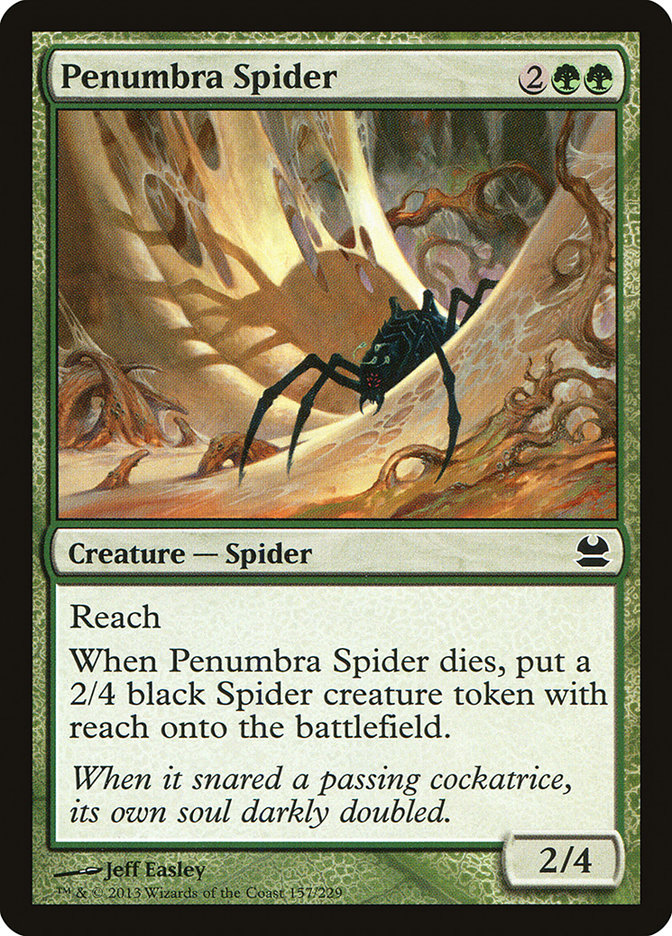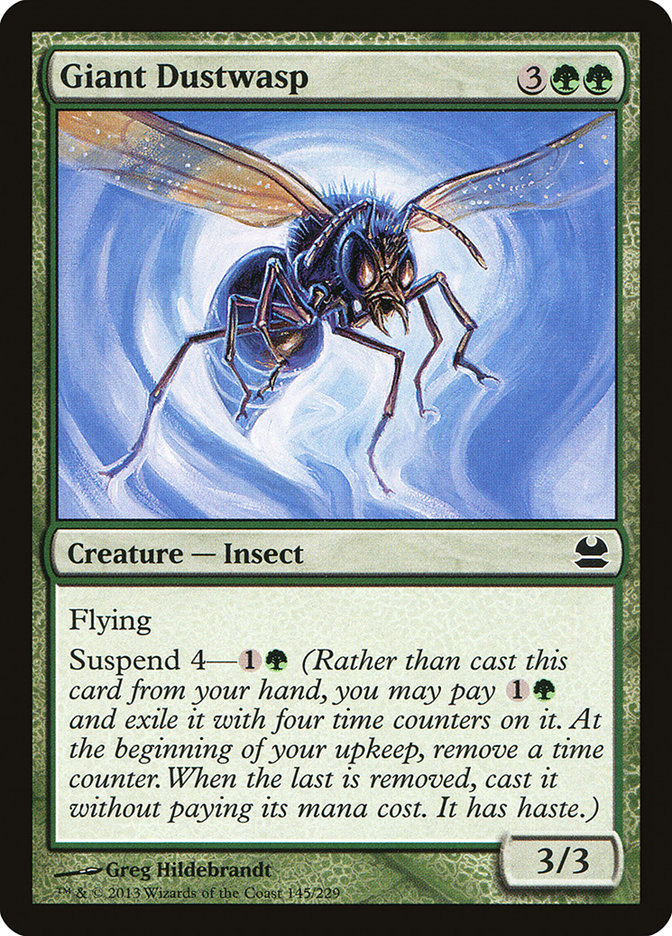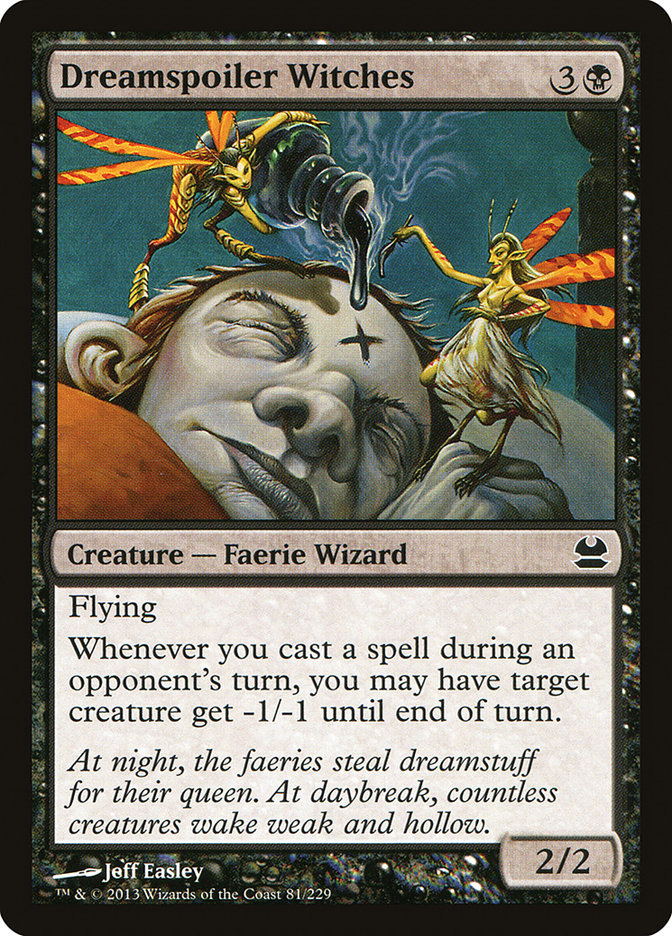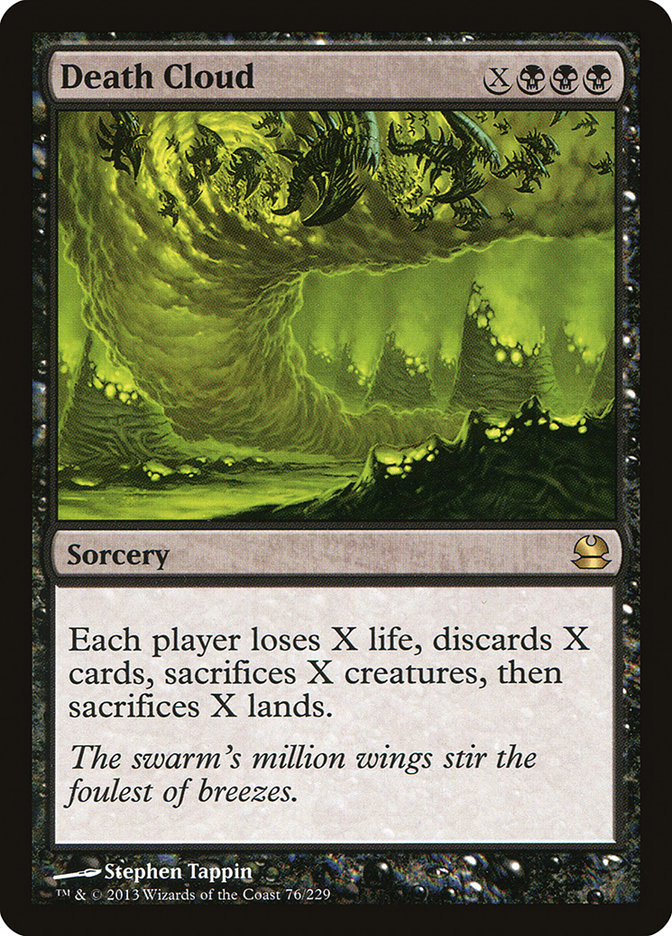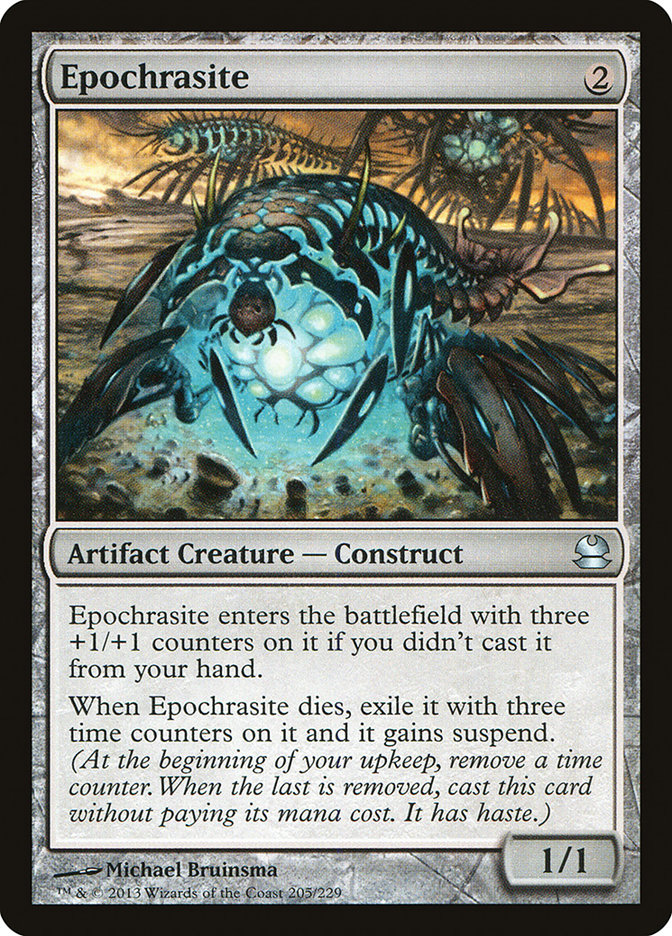Last weekend was the biggest…blah blah blah, I’m sure you’ve heard.
Like everyone else, I was very excited to play in a Modern Masters Grand Prix and prepared by playing about as much of it on Magic Online as I could. For me, this started during Grand Prix Houston. I almost never use my laptop during Grand Prix weekends, but when I got into Houston on Friday, I went to my hotel room and fired up a few drafts rather than trying to go out with people. Saturday morning during my byes, I went to my hotel and drafted, and Saturday night after the tournament, I did quick draft before bed. Sunday evening, I had people come hang out in my hotel room to play Magic Online.
The rest of the week was very similar.
All told, I drafted enough to win nine drafts, so I’d guess I did somewhere around 25-30 drafts.
In case it wasn’t clear, I love this set.
Yes, I’d want to practice for a Grand Prix in a completely new format, but this was obsessive in a way I couldn’t force myself to be if I didn’t enjoy the format.
I was worried at first that because the archetypes were so intentionally created that drafts would end up scripted fairly early or that I’d just find the best two or three decks and force them. What I found is that the excellent cross-theme synergies and abundance of great mana fixing means that you can get really creative. After I found a deck that I liked that just felt like the best deck, I’d force myself to try something else, and I’d be similarly impressed.
Playing this felt like playing M13, which I loved similarly. I was always worried I’d find the best thing and it would get stale, but the more I played and the more I learned how to draft different archetypes, the more I found anything could win or be awesome if drafted properly.
This format has another level though. The default archetypes lead to a rock/paper/scissors type metagame to some extent. Certain deck types are very good against others, so if you just draft, for example, an awesome, fully committed, deeply synergistic Rebel deck, you’ll lose to a similarly focused Thallid deck almost all the time. This rewards branching out to cover all your bases or at least carefully drafting sideboard cards that address your problem matchups. The depth of the packs means that you can do that—you have plenty of time to draft a sideboard as long as you know what to look for.
Outside of the draft, the gameplay is just incredible. I threw away several matches while practicing by making mistakes I should have known better than to make, and I love when a set is challenging enough to make me do that.
This set was designed by WotC as a treat for established players to show that they aren’t ignoring us while expanding their store level programs and finding ways to appeal to new players, and it’s tremendously successful at doing what it’s designed to do. Huey said he’d be happy drafting the set the rest of his life. Ben Stark was a little more conservative/realistic; he said he’d want every tournament for the rest of the year to be this format.
The amount of added depth and additional options created by having each pack essentially contain more cards (fifteen instead of fourteen, but more importantly, they were almost all playable) really makes me wonder if the benefit of printing unplayable cards (eases low level learning curve since new players can learn which cards are bad) is not actually the best use of that space in packs. (I’m more confident than I’d expect to be that drafting would be more fun for players at all levels if 95%+ of cards in a set were good enough that there would always be matchups where you would actively want them in your deck).
Anyway, as for the actual tournament itself, I got in Sunday night later than I’d originally planned. Despite expertly navigating the airline system to avoid missing a connection because of a delay, my final flight was still delayed by an hour, and, more problematically, everyone I was meeting in the airport was also substantially delayed.
While I’d done a lot of drafts, I hadn’t actually played any Sealed events. (Drafts were too fun, and I just couldn’t make myself click on a Sealed event on Magic Online given the relatively horrible prize structure—I don’t care about the ticket or two in equity, but it’s just the principle of the thing. It hurts to click to enter a tournament I can’t win in that I’ll be worse off than I was before I entered the event regardless of outcome). Fortunately, I met Gaudenis Vidugiris at the airport, and he had played Sealed a little. He told me that he thought most decks would be multicolor green decks, and that made a lot of sense.
There’s enough fixing in the format that most Sealed pools should be able to splash for bombs, and Sealed pools don’t actually contain enough cards to fully support most linear strategies. Most of green’s best cards are just good by themselves. Penumbra Spider and Giant Dustwasp don’t particularly care what the other cards in your deck are; they’re just going to be solid creatures.
When I got my pool…well, let me shortcut this. Blake Rasmussen already did a nice write-up here.
I was quite happy with my deck. I showed it to some other players, and while opinions varied slightly on how good my deck was, everyone seemed to think I’d built it properly and chosen the correct deck to play.
I spent my byes in a more traditional way for this tournament than in Houston. I helped some other people with their Sealed pools and ate a huge Ethiopian lunch.
I drew more or less perfectly every game for my first two matches, which is to say between all four games I probably had fewer than ten total unspent mana. I might have suspended Durkwood Baloth every turn 1, cast Pestermite every turn 2, and Imperiosaur every turn 4, also productively using my mana on the other turns.
They were some of the easiest matches I’ve ever played.
I think it was the next round, round 6, when I lost my first game, but even then it was a game where I was far ahead but made a play that turned out to be too aggressive. I lost to an unlikely pair of tricks, and I won the next two games fairly easily.
My round 7 match was incredible. The final game was featured here. At the beginning of this segment, they’re talking about how I had two decks and about sleeving both decks and then subtly swapping to blindside the opponent. I did that—the deck they see me building is actually a third deck. They say I won game 2 with my original deck, which isn’t close to accurate. There were no cards in common between my deck in game 1 and my deck in game 2.
In game 1, I played my original G/U tempo deck, but Alex played a Rebel searcher, two Bound in Silences, a Blinding Beam, and a Slaughter Pact. My huge green creatures and Moldervine Cloaks seemed to match up terribly with that, so I sided into my second deck, which was R/W Giants with Figure of Destiny; Lightning Helix; Feudkiller’s Verdict; Thundercloud Shaman; and Yosei, the Morning Star. While building, I’d completely dismissed black because my best black cards were two Rathi Trappers and two Dreamspoiler Witches, which are good but didn’t seem as impressive as the cards in my other colors. I wanted my red removal against Alex’s Rebels, especially Thundercloud Shaman.
Alex also sideboarded significantly for game 2; he brought in several blue tempo cards, which would have been excellent against my green deck but also felt threatening for my R/W deck.
Once Alex was playing U/W Rebels and Faeries, almost all of his creatures had one toughness, and he wouldn’t be able to permanently answer Dreamspoiler Witches, so I was fairly confident I would win any game where I drew one of them. As we saw, that’s how it played out. Dreamspoiler Witches dominated the early game and allowed me to win through his Cloudgoat Rangers and Yosei, the Morning Star in a fairly epic game 3.
Throughout the rest of the day, I didn’t sideboard another card and just went back to beating people with my Blue/Green deck, though my round 10 match against Jesse Hampton (also featured on video) was very close.
My first draft was covered here. You can actually see it all, so I’m not going to talk through it. The text write-up here sums up where I went with it. As the coverage says, I was very happy with the deck. It’s interesting to note that the coverage thought I was taking Empty the Warrens to hate it from a Storm deck when I was actually taking it as an incredible splash in my deck since Etherium Sculptor and Esperzoa easily allow me to create a giant storm. When I took Grapeshot over Errant Ephemeron, Gavin started to figure out that I actually wanted the storm spells.
My first round was covered on video, but I wouldn’t really recommend bothering to watch it. My opponent didn’t draw enough lands, and I ran him over in relatively unimpressive fashion.
I picked up my first loss in the second match of the draft, losing both games to huge Thundercloud Shaman triggers. Sometimes you just lose to that card.
The final round of my draft against Melissa DeTora was covered here. In game 3, she chump blocked with her last creature to go to three life against my board full of powerful creatures on turn 4 of extra turns, but I knew there was no way she would concede since that would eliminate her from Top 8 contention. I was left settling for a draw and needing to 3-0 my next draft.
I hadn’t been taking care of myself well enough at this point and was definitely having trouble focusing in my second draft. I first picked Death Cloud, an underrated rare that I consider very powerful, over Plumeveil, a card I’d love to start with because I like those colors and I’m generally not unhappy to play it even if I have another color in my deck.
I took an Epochrasite second over Auntie’s Snitch and Aether Vial. Third pick I think I took Sanctum Gargoyle over Aether Vial and then picked up an Esperzoa and a late Plumeveil. Early in the draft, I’d seen two Auntie’s Snitches and a lot of cheap Goblins and was thinking I’d want to stay open to moving in if they tabled, which they did, but I ended up with so many of my favorite artifacts at that point that I couldn’t really switch.
I mostly drafted Affinity similarly to my first draft through the rest of the draft, but in pack 3 I opened Kokusho, the Evening Star with Path to Exile and took the Kokusho, which I think was wrong. My deck ended up far more aggressive than the previous one since I had four Court Homunculuses, which really taxed my color requirements. I hadn’t drafted very aggressive Affinity and just wasn’t as comfortable committing to that plan.
I ended up more confused than the first draft and looked at several possible configurations in deckbuilding. I could play an aggressive blue/white build that splashed Shrapnel Blast and one-to-three Pyrite Spellbombs but also had two Plumeveils that didn’t really fit. Instead, I chose to build a more controlling sunburst Affinity deck with Warren Pilferers and Kokusho, the Evening Star.
I lost my first game; I had a draw that didn’t do much and never played a blue land. For game 2, on the play against R/W Giants, I sided into the aggressive deck, my opponent mulliganed and stumbled, and I blew him out with a Test of Faith on my Court Homunculus against his suspended Rift Bolt.
For game 3 on the draw, I sided back into my control deck but cut my sixteenth land for a Lotus Bloom and also played Death Cloud. I kept a one-land hand with Lotus Bloom, Death Cloud, and Epochrasite on the draw and managed to just barely set up a Death Cloud for three off the Lotus Bloom, killing all of my opponent’s creatures, making him discard his hand, and leaving him with only two lands. It left me with a Sanctum Gargoyle in hand, a Paradise Mantle in play, and two suspended Epochrasites that were coming into play next turn and the turn after.
My opponent drew Kataki, War’s Wage, which was certainly the best card he could have drawn. I immediately lost my Paradise Mantle, but I was lucky enough to draw a land so I could keep my Epochrasite around. The game ended up extremely close, but the Epochrasites were able to take it down.
I lost my next match to a very good G/B control deck. I sided out Engineered Explosives when I went into my fast beatdown build on the play in game 2 against his clunky green and black creatures, but that backfired, as I found myself digging with Faerie Mechanist and Esperzoa against his Skeletal Vampire without an Engineered Explosives in my deck to find to clear out the bats.
That loss eliminated me from Top 8 contention.
In the final round, I was paired down against Shahar Shenhar, who had three losses, and he conceded to me because I would finish in the Top 32 with a win while he could only Top 64 with a win and neither of us would get anything with a loss or a draw.
So I finished 12-2-1. I’m fairly certain I would have made Top 8 of a Grand Prix or maybe two with that record, but here it was good enough for 26th. 4,500 is a lot of players.
Rant about tournament policy below; stop now if you’re just here for strategy.
As a final note, during deckbuilding on Saturday, I tweeted that I didn’t think players should be allowed to drop and keep the product that they opened before the deck swap. I was surprised by how many people disagreed, so I just want to discuss my thoughts on the matter briefly.
It doesn’t make sense to me that anyone has the perception that they own the cards they’re registering for someone else. Everyone knows there is going to be a deck swap, and everyone knows when they open the packs that they’re not intending to keep the cards that are in them—it’s just an anti-cheating measure that you open someone else’s cards. People say they want to avoid a "feel bad" moment when you have to pass something awesome you opened. I get wanting to avoid that, but it happens every time there’s a deck swap and is known going in. It’s just a cost we’ve accepted, and it’s always countered by a "feel good" moment when you get passed something sweet after the swap.
Offering the option to leave with the cards is equity neutral—everyone has the same option, so it doesn’t change anyone’s expected value in the tournament. So why do I have a problem with it?
No one traveled to Grand Prix Las Vegas to open six packs of Modern Masters. They could have done that from home. They came to play. In practice, a couple serious, honest competitors I know opened moderately valuable packs—nothing insane, just about $100 in cards—and dropped from the tournament to keep them. Both had other things they could do with their time in Vegas, cared about the money, and didn’t feel they had great chances in a 4,500-person tournament with few if any byes between them. So I should be happy that they got to do that, right?
No, not at all. I’d argue that they did it because they felt obligated to since they would be making a financially irresponsible decision not to. The head judge made repeated announcements about the process of dropping that essentially amounted to encouraging players to drop with their product. Both of them wanted to play Magic and would have stayed in and played if they were simply not given to option to drop.
People say that you can’t stop people from leaving and that allowing this drop is an anti-theft measure. I’d argue that most players aren’t thieves and if you just tell them they don’t own the product they’ll pass whatever they open, even a foil Tarmogoyf, rather than steal it. I know those two would have. What if these cards are opened by someone less honest? If you’re really worried about the increased opportunity to steal cards, you just can’t have a deck swap.
Anyone could show up to the tournament with a Modern Masters rare and a Modern Masters foil in their pocket, take the most valuable card they opened and substitute that, and get the money card while still playing in the tournament if they have to. That’s about as realistic as someone opening a foil Tarmogoyf and just grabbing their product and running out of the building if they’re told they don’t get to keep the cards they open if they drop.
Are there really any Magic players who would bother to travel to a Magic tournament who are going to throw away their ability to play Magic for a $400 card? Sure, no one’s going to call the cops if you try to run off with the product that isn’t yours, but it’s not hard to ban you from tournaments.
I just don’t understand where the whole idea of dropping and keeping the cards comes from. They never should have been considered yours in any way.
Finally, it bothers me that it changes the equity of the sleep-in special compared to the regular tournament. If 50% of players who opened a Tarmogoyf dropped to keep it, you’re half as likely to get a Tarmogoyf in the pool you’ll build a deck with, while those pools opened and registered by judges all have exactly the cards they were opened with. That might not be a big deal because Tarmogoyf is "only" a very good creature and arguably not a gigantic bomb in Sealed (it’s actually much better in Limited than people seem to realize).
The inequity there might be subtle, but it’s real. As a player who wanted to compete and wouldn’t drop for valuable cards, I both had less equity in the tournament in terms of getting valuable cards and slightly worse chances of having a good deck than players who built their decks later because there is a small correlation between value and quality in Limited play. The impact on competition is negligible but bothers me on principle.
The issue gets even more (needlessly) confusing with the addition of the pass to verify product. If the person opposite me opens a foil Tarmogoyf and doesn’t drop and then hands me the cards to make sure they registered them properly, can I drop and keep it because I happen to be holding it? If not, how is this any different than if I’d registered it? Either way, I’m just trying to keep only the cards in my possession at the moment, not the cards I’m actually supposed to get from the tournament.
This is just going to keep getting more ranty and go in more circles if I continue, so I’m out.
Thanks for reading,
Sam
@samuelhblack on Twitter
twitch.tv/samuelhblack

